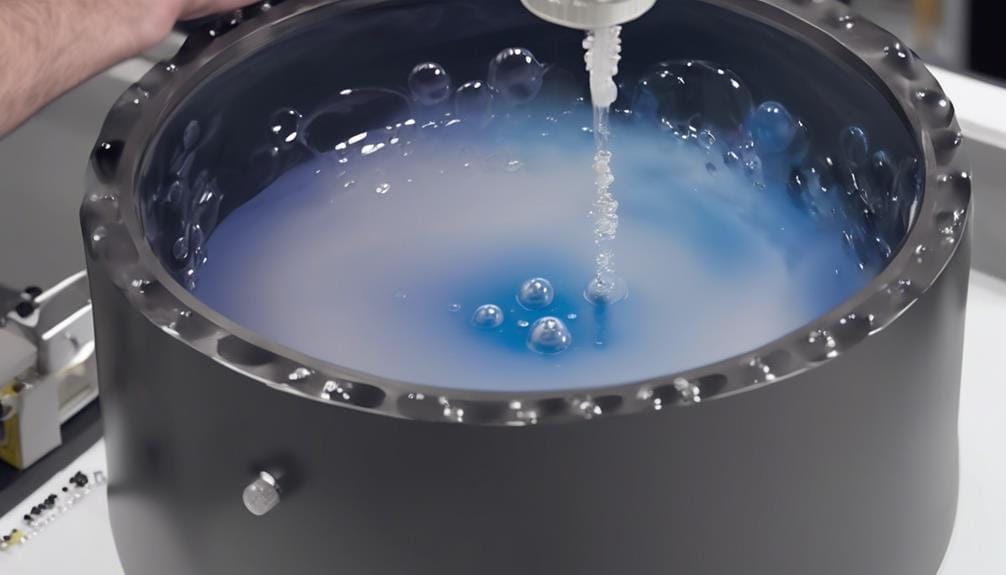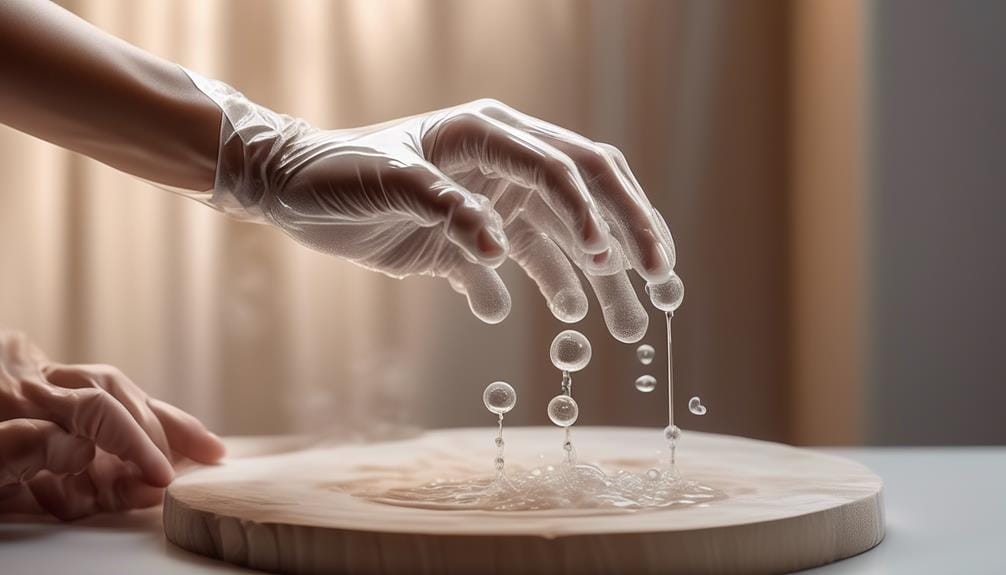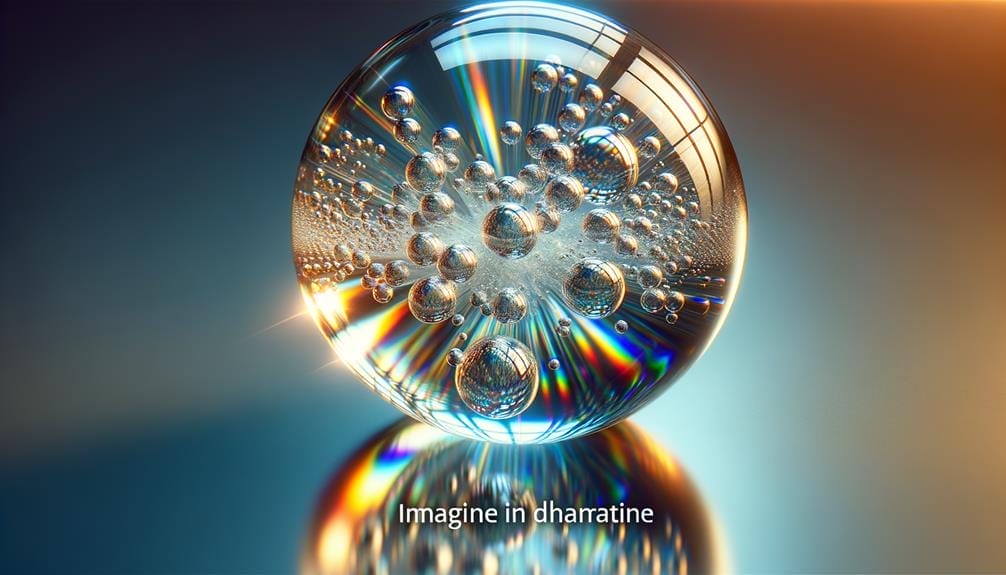You've probably experienced the frustration of applying epoxy only to be left with unsightly bubbles that ruin the final result. But fear not, because there's a solution that promises to eliminate those pesky bubbles and give you a flawless finish: Bubble-Free Epoxy.
This specialized epoxy resin has been designed to tackle the bubble problem head-on, providing you with a smooth and bubble-free surface. But how does it work? And what are the secrets to achieving bubble-free perfection?
Stay tuned as we uncover the magic behind Bubble-Free Epoxy and share some expert tips on how to achieve stunning results every time.
Key Takeaways
- Properly warming the resin and hardener before use can maintain an ideal temperature for better flow and air release, reducing the likelihood of epoxy bubbles.
- Pouring epoxy projects in layers rather than all at once allows for better control and minimizes heat buildup, decreasing the chances of trapping air bubbles.
- Heat treating the wood before applying epoxy helps remove any moisture or air trapped within the wood, preventing bubbles from forming.
- Using techniques such as the roll and tip method, pouring epoxy from the bottom of a container, and degassing the epoxy can help achieve a bubble-free finish.
The Problem With Epoxy Bubbles
The problem with epoxy bubbles arises from various factors, such as cold resin temperatures, pouring an excessively thick layer at once, and mixing the resin and hardener too rapidly, which results in the entrapment of air bubbles in the mixture.
When working with epoxy resin for clear and bubble-free art projects, it's crucial to understand the causes behind bubble formation. Cold resin temperatures can lead to sluggish flow and difficulty releasing trapped air. Pouring a thick layer of resin at once generates more heat and increases the likelihood of entrapping air bubbles. Additionally, mixing the resin and hardener too rapidly introduces air into the mixture.
To combat these issues, it's essential to warm the resin and hardener bottles in warm water before use, maintaining an ideal temperature for better flow and air release. Pouring projects in layers rather than all at once allows for better control and minimizes heat buildup. After each layer, using a heat torch with sweeping movements helps eliminate surface bubbles.
It's also helpful to prick away any remaining bubbles with a cocktail stick and spritz rubbing alcohol to remove bubbles without creating ripple effects. By understanding and addressing the factors contributing to epoxy bubbles, one can achieve clear and flawless resin art projects.
How Bubble-Free Epoxy Works
To understand how bubble-free epoxy works, it's important to grasp the techniques used to prevent bubble formation. This includes warming the resin before use and pouring it from the bottom of a container.
Additionally, proper application techniques are crucial in achieving a smoother finish. For example, it's important to avoid coating wood while it's warming, as this can lead to the formation of bubbles.
Bubble Formation Prevention
To prevent the formation of bubbles in epoxy, consider heat treating the wood before applying the epoxy. This step helps to remove any moisture or air trapped within the wood, which can cause bubbles to form as the epoxy cures.
Additionally, using a clear casting resin specifically designed to minimize bubble formation can also be effective.
When applying the epoxy, it's important to use techniques that promote a bubble-free finish. For vertical surfaces, the roll and tip method can be used, where the epoxy is rolled onto the surface and then smoothed out with a brush using long, even strokes.
When pouring epoxy into a container, pouring from the bottom can create a bubble-free flow coating.
Lastly, it's important to avoid coating wood while it's warming, as this can also lead to the formation of bubbles.
Epoxy Application Techniques
For a bubble-free epoxy application, consider employing specific techniques to ensure a smooth and flawless finish. Whether you are working with traditional epoxy resin or a clear cast resin kit, these techniques can help you achieve professional results. One technique is to warm up the resin and hardener before mixing them together. You can do this by placing the bottles of resin into warm water for a few minutes. Another technique is to pour the mixed resin from the bottom of a container, creating a bubble-free flow coating. Additionally, when applying epoxy to vertical surfaces, use the roll and tip method to evenly coat the surface and minimize the formation of bubbles. By following these techniques, you can effectively eliminate bubbles and achieve a perfect epoxy finish.
| Technique | Description |
|---|---|
| Warm up the resin and hardener | Place the bottles of resin into warm water for a few minutes to warm them up before mixing. |
| Pour from the bottom | Pour the mixed resin from the bottom of a container to create a bubble-free flow coating. |
| Roll and tip method | Use a roller to apply the epoxy, then use a brush to tip off any bubbles and ensure an even coat. |
Ensuring Smooth Epoxy Surface
To achieve a smooth and flawless epoxy surface with no bubbles, it's important to employ specific techniques throughout the application process.
Start by using a bubble-free resin, such as clear epoxy resin, which is commonly found in resin kits and used for various resin projects. When working with casting epoxy, it's crucial to understand its working time and follow the manufacturer's instructions.
To ensure a smooth finish, heat the wood before applying the epoxy to prevent bubbles from forming. Additionally, use the roll and tip method for coating vertical surfaces with epoxy, and pour the epoxy from the bottom of the container to create a bubble-free flow coating.
Finally, be sure to degas the epoxy using a vacuum degassing chamber and remove any bubbles that may have formed before and after the epoxy cures.
Tips for Preventing Air Bubbles
Prevent air bubbles while applying epoxy by heating the wood beforehand. This is an effective technique because air bubbles tend to form when the epoxy comes into contact with cold surfaces. By heating the wood prior to applying the epoxy, you can minimize the risk of air bubbles forming.
Here are some additional tips for preventing air bubbles:
- Use the roll and tip method: When coating vertical surfaces, such as walls or furniture, use a roller to apply the epoxy and then follow up with a brush to smooth out any bubbles that may have formed. This method helps to evenly distribute the epoxy and reduce the chances of air bubbles.
- Pour epoxy from the bottom of a container: When mixing the epoxy, pour it from the bottom of the container instead of pouring it directly onto the surface you're working on. This technique creates a bubble-free flow coating, as any air bubbles will rise to the top of the container and not be transferred onto your project.
- Avoid coating wood while it's warming: If you're working in a cold temperature environment, it's important to wait until the wood has reached room temperature before applying the epoxy. Coating the wood while it's still warming can cause air bubbles to form as the epoxy reacts to the temperature change.
Degassing Techniques for Bubble-Free Casting

To achieve bubble-free casting, there are three key degassing techniques to consider.
First, using a vacuum chamber method with a vacuum pressure of at least 25 inches of mercury for 5-10 minutes effectively removes air bubbles from the epoxy.
Second, employing a heat gun technique allows you to gently apply direct heat to the resin surface, eliminating surface bubbles.
Lastly, thorough stirring and settling of the resin and hardener for at least 3 minutes before pouring helps prevent the formation of bubbles.
Vacuum Chamber Method
Using a vacuum degassing chamber is an effective method for achieving bubble-free casting in epoxy resin. When it comes to removing bubbles, this technique is highly recommended. Here are three key reasons why the vacuum chamber method is so beneficial:
- Complete Bubble Removal: The vacuum chamber creates a low-pressure environment that allows air bubbles to rise to the surface and escape. This ensures that your epoxy resin is free from any trapped air, whether the bubbles are big or small.
- Efficient Cure Time: By using the vacuum chamber method, you can significantly reduce the curing time of your epoxy resin. The removal of bubbles allows for a more uniform curing process, preventing issues like fisheye or uneven surfaces.
- Protects Your Mold: Bubbles can cause damage to your mold, resulting in imperfections in your final casting. With the vacuum chamber method, you can eliminate this risk and ensure that your mold remains intact.
Heat Gun Technique
The heat gun technique is an effective method for achieving bubble-free casting in epoxy resin by using gentle, even heat to remove air bubbles from the surface. By sweeping the heat gun over the resin at a safe distance, you can pop surface bubbles and ensure a smooth finish on your project.
It's important to apply the heat evenly and avoid overheating or holding the heat gun in one area for too long, as this can damage the resin. The heat gun technique is a popular choice for degassing and achieving bubble-free casting in resin projects.
Experiment with different heat gun distances and techniques to find the best method for your specific casting needs.
Stirring and Settling
When employing the heat gun technique for achieving bubble-free casting as discussed previously, one crucial aspect to consider is the stirring and settling process, which utilizes specific degassing techniques to ensure a flawless outcome.
To achieve a transparent and clean result, follow these steps:
- Stir the epoxy resin thoroughly to distribute the hardener evenly, ensuring a proper chemical reaction.
- Allow the mixture to settle for a few minutes to allow any trapped air bubbles to rise to the surface.
- Use a stirring tool to gently remove any large air bubbles that have surfaced.
Removing Bubbles in Uncured Epoxy

To effectively eliminate bubbles in uncured epoxy, consider employing techniques that promote even distribution of the epoxy mixture. When working with epoxy, it is common to encounter bubbles, which can mar the final appearance of your project. To ensure a bubble-free epoxy finish, you need to address this issue during the application process. Here are some techniques you can use to remove bubbles in uncured epoxy:
| Technique | Description |
|---|---|
| Heat gun | Gently pass a heat gun over the epoxy surface to apply heat. This will cause the bubbles to rise and burst, leaving a smooth finish. Be cautious not to overheat the epoxy, as it can cause discoloration or other issues. |
| Torch | Similarly to the heat gun, a torch can be used to remove bubbles. Move the flame of the torch in a circular motion over the epoxy surface. This will heat the epoxy and cause the bubbles to pop. Again, be mindful of overheating the epoxy. |
| Vacuum chamber | If you have access to a vacuum chamber, you can place your epoxy resin casting in it to remove bubbles. The reduced air pressure inside the chamber will cause the bubbles to expand and rise to the surface. Once the bubbles have risen, release the vacuum and allow the epoxy to cure. |
| Toothpick | For smaller craft projects or areas that are difficult to reach, a toothpick can be used to manually remove bubbles. Gently poke the bubbles to release the trapped air. |
| Epoxy resin with low viscosity | Using a clear epoxy resin with low viscosity can help minimize the formation of bubbles. These resins have a thinner consistency, allowing bubbles to rise and escape more easily during the curing process. |
Post-Cure Bubble Removal Methods
Consider implementing post-cure bubble removal methods to achieve a flawless finish on your epoxy project. After the epoxy has fully cured, there are several effective techniques you can use to remove any remaining bubbles and achieve a bubble-free epoxy surface.
Here are three recommended post-cure bubble removal methods:
- Sanding: Once the epoxy has completely cured, you can sand any bubbles that are near the surface. Use a fine-grit sandpaper and gently sand the affected area until the bubbles are no longer visible. After sanding, you can apply more epoxy using a spreader to fill any remaining pinholes.
- Heat Treatment: Another effective method is using heat to remove bubbles from the surface of the cured epoxy. You can use a propane torch or a heat gun to apply gentle heat to the epoxy surface. Move the heat source back and forth over the bubbles until they disappear. Be careful not to overheat the epoxy, as this can cause damage.
- Vacuum Degassing: If you're working with Entropy CCR epoxy, you can utilize a vacuum degassing chamber to remove air bubbles. Place your cured epoxy piece in the chamber and maintain a vacuum pressure of at least 25 inches of mercury for 5-10 minutes. This process will effectively pull out any trapped air bubbles, leaving you with a bubble-free epoxy surface.
Recommended Applications for Bubble-Free Epoxy

Bubble-Free Epoxy is a versatile and high-quality coating recommended for various surfaces, including tables, bar tops, countertops, and tumblers, thanks to its ability to provide a thick, glossy finish. This clear epoxy resin is perfect for a wide range of applications, making it a must-have for crafters and DIY enthusiasts alike.
| Recommended Applications | Description |
|---|---|
| Laminating and Fiberglass | Bubble-Free Epoxy is suitable for laminating and applying fiberglass, making it an excellent choice for creating durable and clear layers in art and craft projects. Whether you're working on a painting or a tabletop, this epoxy ensures a smooth and transparent finish. |
| Casting | If you're into resin jewelry making, ornaments, or art castings, Bubble-Free Epoxy is the resin kit for you. Its low odor and bubble-free formula make it easy to create stunning and flawless resin creations. |
| Art Projects | Artists can explore various techniques using Bubble-Free Epoxy. Whether you're into fluid resin art, ocean wave resin art, 3D flow resin art, or resin petri art, this epoxy's self-leveling and transparent properties will help you achieve professional-looking results. |
With its transparent finish, low odor, and bubble-free formula, Bubble-Free Epoxy is the go-to choice for anyone looking to create clear and flawless resin projects. Whether you're a beginner or an experienced crafter, this epoxy resin offers a crystal clear finish that will elevate your creations to the next level. Get your hands on Bubble-Free Epoxy and unlock the endless possibilities of resin crafting.
Top Bubble-Free Epoxy Products on the Market
With the versatility and quality of Bubble-Free Epoxy in mind, let's now explore the top epoxy products available on the market that offer the same bubble-free properties.
- Clear Epoxy Resin: This product is known for its crystal-clear finish, high gloss, and transparent appearance. It provides a clean and professional look to any project. The clear epoxy resin is also resistant to yellowing, ensuring that your work remains pristine over time.
- Clear Cast Resin Kit: The clear cast resin kit offers a bubble-free solution that's perfect for various applications. It provides a smooth and glossy finish, making it ideal for tabletops and other surfaces. This kit is easy to use and provides a strong and durable final result.
- Let's Resin Clear Resin Kit: The Let's Resin clear resin kit is a popular choice among DIY enthusiasts. It offers a bubble-free and transparent finish that's ideal for a wide range of projects. This kit is easy to use and provides a high-quality result, with excellent adhesion and minimal shrinkage.
These top epoxy products on the market provide a bubble-free and crystal-clear finish. Whether you're working on DIY projects or professional applications, these epoxy products offer the perfect solution for achieving a high gloss and transparent appearance. Their yellowing resistance ensures that your work will maintain its clarity and beauty over time.
Frequently Asked Questions
How Do You Make Epoxy Not Bubble?
To prevent bubbles in epoxy, warm up the resin and hardener, mix thoroughly, and pour in layers. Use a heat gun to eliminate bubbles on the surface and a vacuum degassing chamber to remove air.
Is There a Bubble Free Resin?
Yes, there is bubble-free epoxy resin available. To achieve a flawless finish, try warming up the resin before use, sealing objects completely, and using intentional movements when mixing and pouring. Experiment with techniques and share tips for a great experience.
What Is the Best Resin for No Bubbles?
The best resin for achieving a bubble-free finish depends on various factors such as technique, brand, and proper mixing. Follow epoxy troubleshooting tips, prevent bubbles by sealing objects, and remove them during curing for optimal results.
Is It Normal for Epoxy to Bubble?
Yes, it is normal for epoxy to bubble. Common causes include cold resin, pouring thick layers, fast mixing, trapped air, and excessive heat torch usage. Prevent bubbles by warming wood, using the roll and tip method, and avoiding coating while warming.
Conclusion
In conclusion, Bubble-Free Epoxy is a reliable and effective solution for eliminating bubbles during the epoxy curing process. Its unique formulation and self-leveling properties make it a great choice for DIY projects.
With its low odor, resistance to yellowing, and water resistance, this epoxy offers long-lasting and high-quality results. Whether you're a beginner or an experienced user, Bubble-Free Epoxy provides a crystal clear finish that's affordable and consistently delivers excellent performance.





